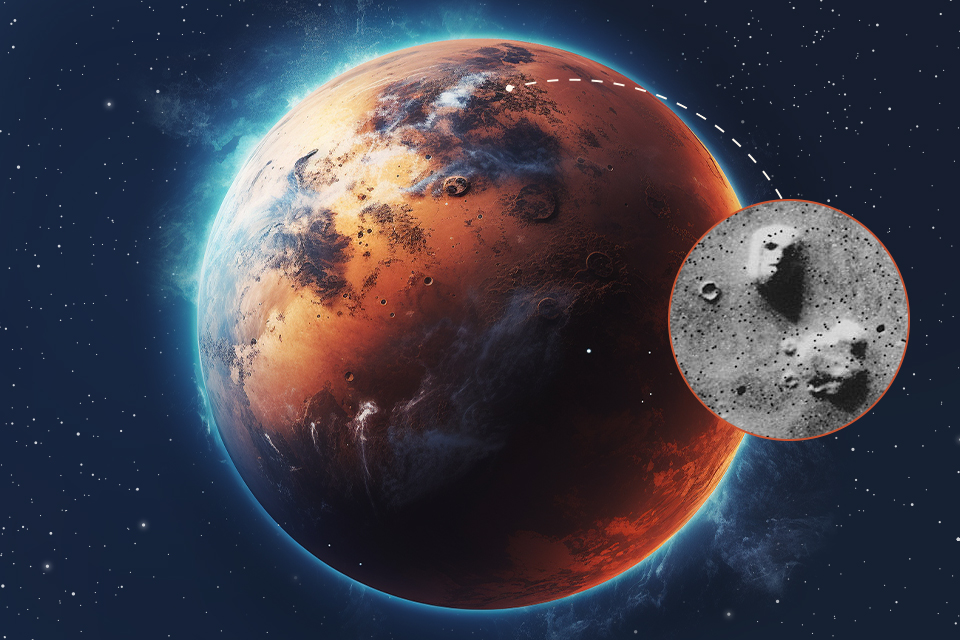In the early 1970s, humanity finally became convinced that the Martian canals were just an illusion. However, already in 1977, it became known about a new object that could be regarded as evidence that a developed civilization once existed on the Red Planet. We are talking about the famous “face on Mars”, or the “Martian sphinx”.

1. What is the “Martian Sphinx”?
The object, which received the name “face on Mars” from NASA employees and was later called the “Martian sphinx” by journalists, was discovered in a photograph of an area known as Cydonia (or Kidonia). They really show a hill, very reminiscent of a human face in a strange headdress, directed vertically upwards.
The picture was taken on June 25, 1976, by Viking 1. Later, scientists found another photo in which the same “face” could be seen from a different angle. The resolution of both images is 50 m per pixel. In fact, the spacecraft took significantly more pictures, but almost all of them had a lower resolution, so it was impossible to see the “face” on them.
2. What is Cydonia?
Cydonia is a small region in the Northern Hemisphere of Mars, distinguished by its albedo. It borders the Arcadia Planitia and the Arabia Terra highlands. It got its name from the ancient Greek polis, which was located on the island of Crete.
Kidonia consists of three very different parts: Cydonia Colles is an area where there are small hills, the Labyrinth of Cydonia is a chaotic jumble of valleys intersecting at different angles, and the Table Mountains of Cydonia, where the landscape is composed mainly of large hills with flat tops and steep slopes. The “Martian sphinx” is located in the last area.
3. Where did the “Martian Sphinx” get to?
Although doubts about the reality of the “face on Mars” appeared almost immediately, people continued to believe in its existence for many years. Only in 2001, the Mars Global Surveyor spacecraft took a new image with a significantly better resolution than Viking I. It clearly showed that a giant face, which was thought to be carved out of stone, was in fact the same flat-topped hill as many other hills around.
The fact that this quite natural object appeared similar to a human face was due to the play of light and shadow. In 2007, another probe, the Mars Reconnaissance Orbiter, also photographed it and again found only Table Mountain.
4. Why did people see faces in the rocks?
In addition to the shadows that very successfully fell on the rock in 1976, people’s perception of it as a “face on Mars” was also associated with the phenomenon of pareidolia. It lies in the fact that the brain tends to see certain images — most often human figures and faces — where they actually do not exist. Thanks to this phenomenon, people often perceive even quite natural earthly objects as fantastic statues.
In the case of the “face on Mars”, the ability to autosuggestion at some point reached the point that people began to consider the rocks around the “sphinx” as pyramids, although in fact they did not have any particularly correct shape, and this is perfectly visible on more detailed pictures.
5. Are there other “faces” on Mars?
It is difficult to say about the role played by the media in spreading the myths about the “face on Mars”, but it was definitely considerable. After all, there are enough other objects that may well claim to see something man-made in them. An example would be the Galle crater, which is extremely similar to a smiley face. It was first discovered by the same Viking 1, but it never caused such a hype as Cydonia.
Another example is a quite ordinary landscape formation in which people have seen the hero of the “Muppet Show”, Kermit the frog.
Follow us on Twitter to get the most interesting space news in time
https://twitter.com/ust_magazine
